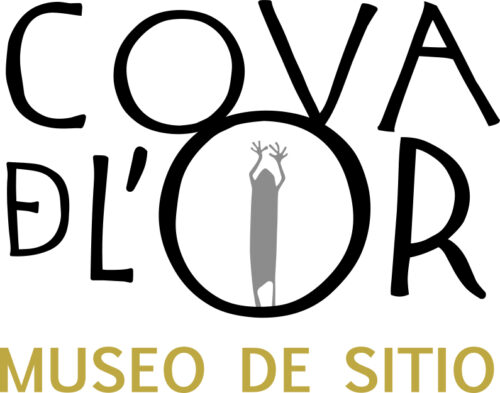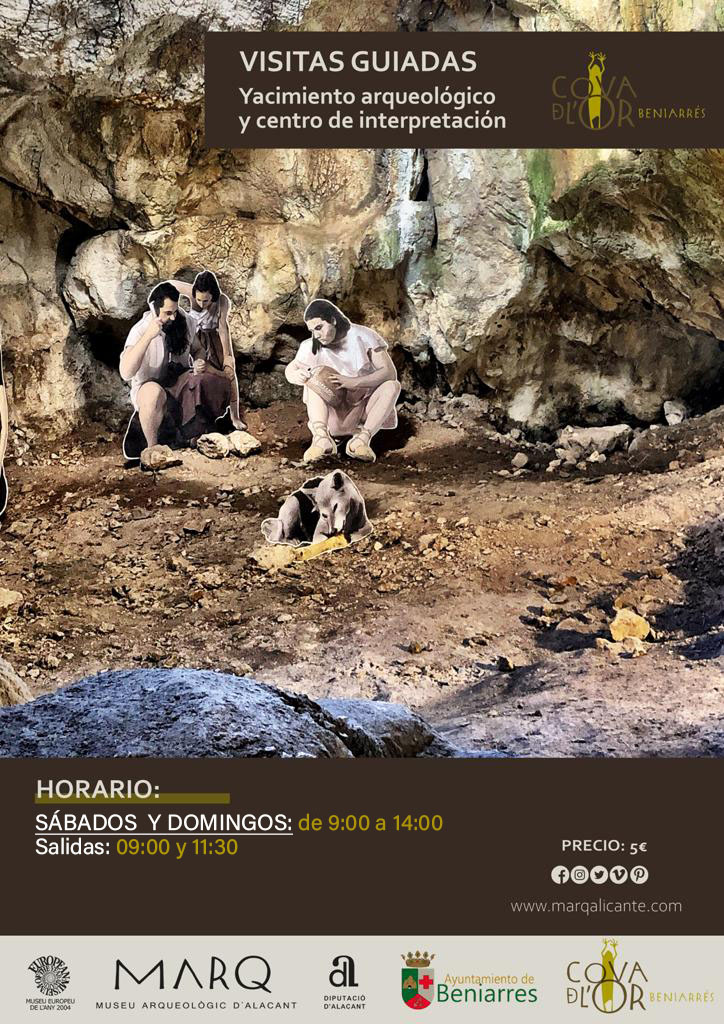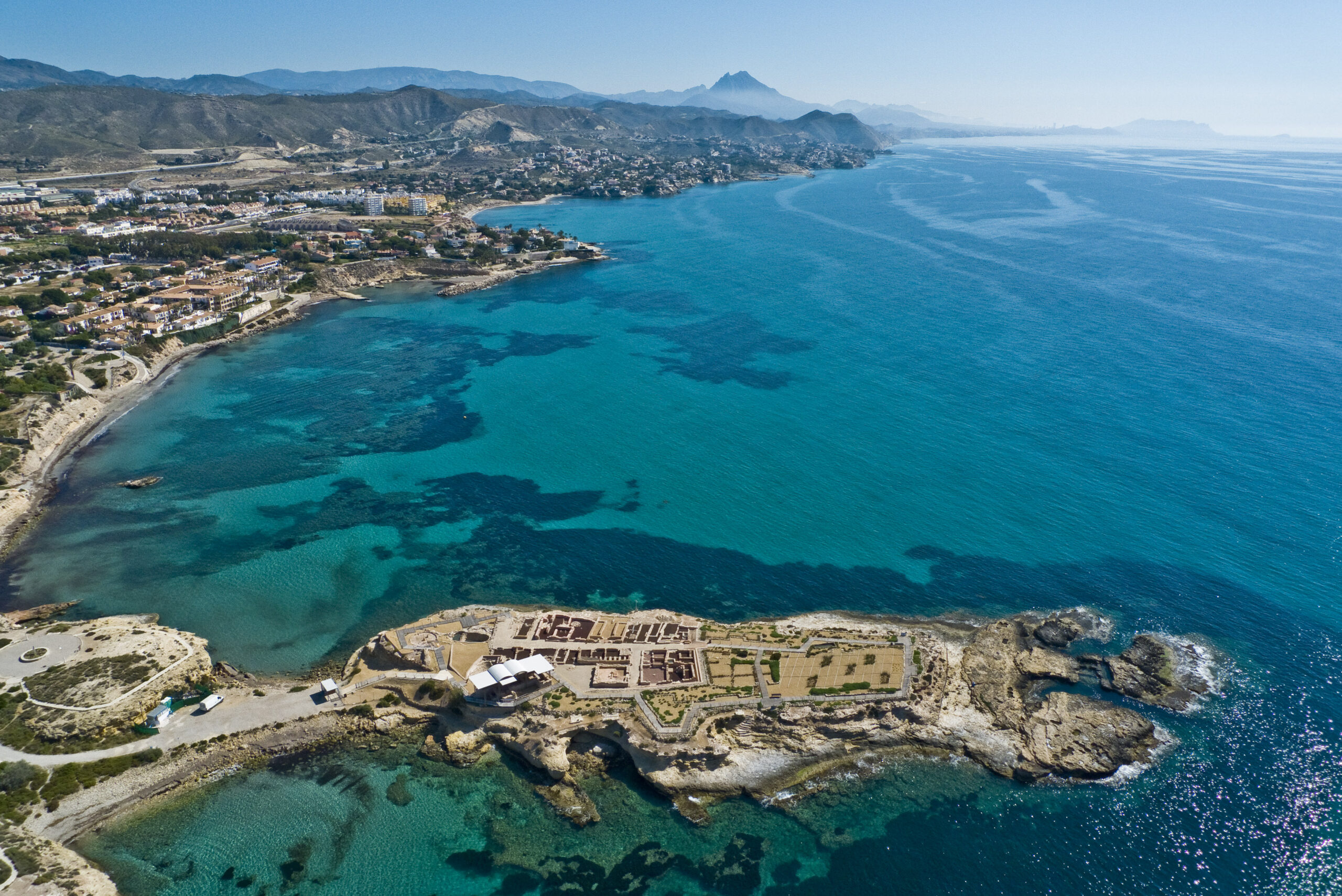COVA DE L'OR

The sanctuary of the Cova de l'Or
The material elements found in the Beniarrés cave testify to the importance of the occupation in the Ancient Neolithic period (5500-5000 BC), when the cave was an ideal place for habitation. The accumulations of wheat and barley seeds, typical of ancient cultivation, date from this period, and their first practice dates back to the Near East. The observation of some burials, the quality of the materials and the abundance of roasted cereal for storage point to the cave and its immediate surroundings as a special place where ceremonies and rites could have taken place.
The ceramics printed with shells (cardial printing) date from this period, especially those whose decoration includes human figures with their arms raised, alone in a praying position, or in a group evoking a dance. The symbolism of this pottery is defined within the movable aspect of Macro-schematic Art, which links the cave to the Rock Art sanctuaries of that chronology, such as La Sarga (Alcoy) or the Pla de Petracos (Castell de Castells), and the Cova de l'Or may have participated in some kind of ritual cycle linked to these enclaves of meetings and encounters.


Cova de l'Or Neolithic archaeological site
The Cova de l'Or in Beniarrés is located 675 m above sea level on the southern slope of the reliefs that make up the Benicadell mountain range. It contains an archaeological site of enormous importance for the knowledge and research of the Neolithic period on the Mediterranean coast of the Iberian Peninsula. The quality and significance of the archaeological material found in the excavations carried out since the 1930s suggest that the cave was a place of social reference for the inhabitants of Mediterranean origin who, in the middle of the 6th millennium BC, introduced the practice of agriculture and livestock farming in these valleys.
Declared an Asset of Cultural Interest, it is now open to guided tours, culminating a suggestive route of cultural and scenic interest that can be started at the Interpretation Centre in the town of Beniarrés. This exhibition shows the technical and research work that has made it possible to open it to the public.
Cova de l'Or. Archaeological excavations
Opening up in the Cretaceous limestone relief, the karst cavity has an elongated floor plan with a SW-NE orientation and a rectilinear roof that increases in height with respect to a steeply sloping floor, from the entrance to the bottom. This slope has facilitated the contribution of sediments from the slopes, a phenomenon of clogging combined with the detachment of blocks, as a result of the development of fissures and fractures in the walls and roof. Although compartmentalised by these volumes and the rock walls, the space is open-plan, benefiting from sunlight through the wide floor entrance and a lantern-shaped roof cavity.
Discovered in the 1930s, archaeological excavations have been carried out in the cave by the Municipal Archaeological Museum of Alcoy and mainly by the Museum of Prehistory of Valencia, revealing a sequence that covers the entire development of the Neolithic period (5500-2800 BC). The most fruitful excavation campaigns were directed in the 1950s by Vicente Pascual Pérez and in the 1970s and 1980s by Bernat Martí Oliver, affecting areas close to the entrance. In the 21st century, the MARQ has proposed interventions in relation to the project to enhance and open up the cave, which have allowed for a better understanding of the mouth of the cave and its surroundings, as well as recovering materials from the sieving of the excavations in the 1950s. The objects found at the site occupy an important place in the archaeological museums of Alcoy, Alicante and Valencia.


Cova de l'Or. Enhancement
The dominance of the valley landscape, the spaciousness of the area and the solar illumination would make the cavity an ideal place for human habitation and habitation. The excavations bear witness to this use, with evidence of foodstuffs and household goods from the family groups that occupied it. Cereal seeds, such as wheat and barley and leguminous plants, such as broad beans, lentils and peas, and remains of fauna that identify sheep, goats, pigs and, to a lesser extent, bulls and dogs. These were agricultural and livestock farmers who supplemented their diet by hunting rabbits, deer, roe deer, wild boar and aurochs.
The evocation of that room has inspired the entire enhancement project, recovering the mouth of the cavity, cleaning the interior and placing human-scale figures under the entrance oculus. Developed by the Department of Architecture of the Provincial Council of Alicante, the work began in 2016 and will culminate in 2020. Access has been improved, the exterior has been fitted out for visits, the cave has a new enclosure and a walkway has been installed to access the interior and immerse oneself in the atmosphere of those early Neolithic times.
Cova de l'Or. Site Museum
Now is the time to visit the Cova de l'Or site, an enclave of enormous cultural importance equipped with the means to facilitate access and make its significance in the Neolithic period understandable. Thanks to an agreement between the Beniarrés Town Council and the C.V. MARQ Foundation, a guide service is offered to cover the visit to the interpretation centre and the cave.
The plan offers weekend visits by prior arrangement. It includes travel by vehicle to the start of the path, near an old quarry. On foot, the route covers about 850 m, over slopes of no more than 20%. The route takes advantage of old terraces and offers a spectacular view of the Benicadell mountain range. At the entrance, once the gate is open, the guide installs the solar panels that give a dim light to the interior. His explanation deals with the achievements of those settlers who more than 7,000 years ago enjoyed an environment that we have a duty to respect.

DIDACTICS AND ACCESSIBILITY
Now is the time to visit the Cova de l'Or site, an enclave of enormous cultural importance equipped with the means to facilitate access and make its significance in the Neolithic period understandable. Thanks to an agreement between the Beniarrés Town Council and the C.V. MARQ Foundation, a guide service is offered to cover the visit to the interpretation centre and the cave.
The plan offers weekend visits by prior arrangement. It includes travel by vehicle to the start of the path, near an old quarry. On foot, the route covers about 850 m, over slopes of no more than 20%. The route takes advantage of old terraces and offers a spectacular view of the Benicadell mountain range. At the entrance, once the gate is open, the guide installs the solar panels that give a dim light to the interior. His explanation deals with the achievements of those settlers who more than 7,000 years ago enjoyed an environment that we have a duty to respect.

ILLETA DELS BANYETS
The Illeta dels Banyets is one of the longest known and excavated archaeological sites in Alicante. It is located in the municipality of Campello, in the...
WINTER TIMETABLE
FROM TUESDAY TO FRIDAY: 12:00h
SATURDAYS: 12:00h and 16:00h
SUNDAYS AND PUBLIC HOLIDAYS: 12:00h
FROM TUESDAY TO SATURDAY
From 10:00 a.m. to 2:00 p.m.
From 15:30 h to 17:30 h
SUNDAYS AND PUBLIC HOLIDAYS
From 10:00 to 14:00 H
MONDAY CLOSED
> Wear comfortable shoes and a cap/hat.
> It is suggested to bring a bottle of water and sun protection.
